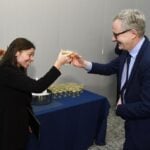INBT’s Symposium Features Undergrad Student Researchers

The Hopkins Institute for NanoBioTechnology (INBT) brings together the leaders from the diverse fields of medicine, engineering and nanoscience to devise ways to further our society’s knowledge and tools to solve the challenges we face in health care. On Nov. 7 at the INBT Fifth Annual Undergraduate Research Symposium, Hopkins undergraduate students presented posters on the research they conducted. Alanna Farrell, who is part of the INBT Undergraduate Leaders — the student group who helped organize the event — explained that the symposium is one of the ways that the INBT attempts to create a sense of community among student researchers.
“The purpose of the group is to have a few people from the different labs in INBT to give undergraduates the responsibility to form a community between the other undergraduates in INBT,” she said in an interview with The News-Letter.
For Farrell, they try to create a community for undergraduate researchers so that they will support each other in their scientific pursuits. These student researchers can turn to each other for additional resources for their research projects or even help with analyzing data and formatting poster presentations. The students presentations ranged from cancer research to heart valve research to determining the optimal refueling time for athletes.
Junior Chemical and Biomedical Engineering major Linda Procell presented her project titled “Characterization of microvasculature and collagen composition in soft tissue sarcomas.” She focused on a rare type of soft tissue sarcoma known as undifferentiated pleomorphic sarcomas (UPS).
“We wanted to look at the morphology of these tumors and what different characteristics mean, for us it was microvasculature and collagen and the roles they play in hypoxia and metastasis,” Procell explained.
UPS is highly prone to metastasis, which is when a tumor in one area of the body forms a secondary tumor in another area. Metastasis is closely linked to hypoxia, which is a low concentration of oxygen at the center of these tumors. She compared hypoxic and non-hypoxic tumors by visualizing both the collagen and vasculature with stains and analyzing if the vasculature aligns with the collagen deposition. Ultimately, she wanted to definitively link two different characteristics of tumors and attribute them to the tumor’s morphology. But the results did not show an association between the two.
“We thought that vasculature and collagen would have a concrete linkage, but they didn’t. Our next step is to see if vasculature can be linked to stress relaxation,” she said.
Although Procell faced a couple of obstacles, such as the failure of certain biomaterials or the lack of tumor development in some mouse models, her passion for cancer research helped her through.
Another presenter, junior Jessica Shen, piloted her own research project titled “Effects of Storage on Mechanical Properties of Fibrin Small Diameter Vascular Grafts.” She works with Morgan Elliot, a graduate student who developed a method for creating man-made, acellular, natural polymer grafts made of fibrin. These grafts are distinct from the current synthetic polymer grafts because they can degrade much faster. The researchers wanted to increase the shelf-life of these grafts, so Shen designed an experiment to test their optimal ambient storage temperature. She tested the grafts at -20 degrees Celsius, four degrees Celsius and 23 degrees Celsius (a freezer, a fridge and room temperature) and at three-month intervals. At the end of each time period, she mechanically tested the grafts by applying a radial stress until they broke.
“Room temperature is the optimal storage temperature. The most surprising finding I had was that at -20°C the grafts actually increased in strength,” Shen said.
Her next project is to figure out the mechanism that causes the varying strengths at different temperatures. This would also allow for her lab to integrate those properties into the graft and get rid of the polycaprolactone (PCL) sheath that is currently needed to provide the graft extra strength.
“Ridding the graft of the PCL sheath will get rid of the synthetic polymer, which is always the goal,” Shen said.
The overarching goal of her lab is to design better alternatives to tools which are currently being used in coronary bypass surgery.
Each presenter was judged on criteria like the project’s impact on the scientific community and the depth of their presentation. Junior Siddharth Iyer, sophomore Keva Li and junior Vivek Gopalakrishnan won first, second and third place respectively. The attendees voted for senior Christopher Domalewski’s poster as the Fan Favorite. Shen advised everyone to get involved in research, even if it’s only to determine whether it’s a potential interest.
“It teaches you critical thinking skills. I believe learning is half inside the classroom and half outside, and research is the outside part of it,” Shen said.
Procell saw the symposium as a way to get others excited about research. She encouraged others to overcome whatever qualms they have.
“Go for it. Don’t be afraid to explore new stuff. When I came to this school, I really wanted to do an internship and go into industry after. Starting research made me really want to continue in research and continue with my education,” Procell said.

Story by Medha Kallem. This story was featured in The Johns Hopkins News-Letter on November 14, 2019 and was reposted with permission.
See INBT’s Facebook page for photos of the event.
Latest Posts
-
 Cellular building blocks may enable new understanding of the body’s “machinery”
December 19, 2025
Cellular building blocks may enable new understanding of the body’s “machinery”
December 19, 2025
-
 Biomedical Engineer Jamie Spangler Receives President’s Frontier Award
December 15, 2025
Biomedical Engineer Jamie Spangler Receives President’s Frontier Award
December 15, 2025
-
 Johns Hopkins Postdoc Named in Forbes `30 Under 30′ List
December 8, 2025
Johns Hopkins Postdoc Named in Forbes `30 Under 30′ List
December 8, 2025


